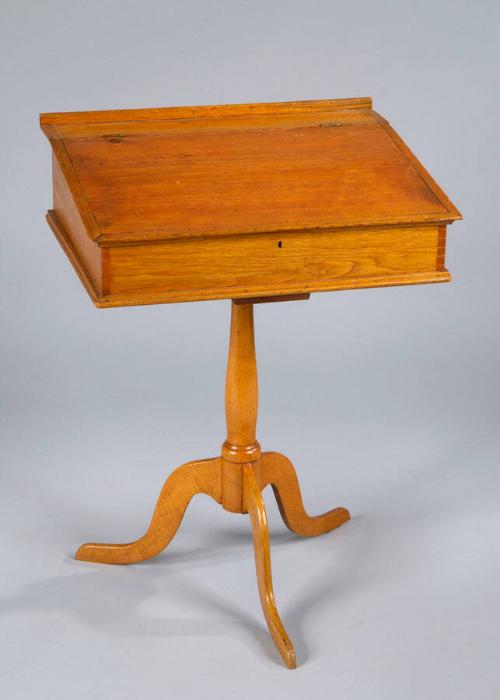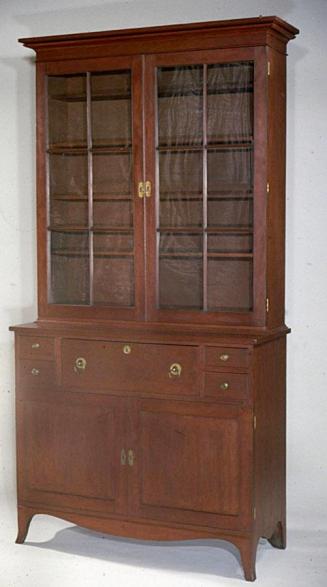Desk
Original OwnerProbably originally owned by
Enfield Shaker Community
(American, 1792 - 1918)
MakerMade by
Unknown
Date1825-1875
MediumButternut and maple primary woods, pine secondary wood, brass and iron hardware
DimensionsPrimary Dimensions (overall height x width x depth of writing desk): 29 x 21 5/16 x 16 5/8in. (73.7 x 54.1 x 42.2cm)
Component (maximum width between two feet): 19 9/16in. (49.7cm)
ClassificationsFurniture
Credit LineMuseum purchase
Object number1998.27.0
DescriptionButternut and maple desk in the Shaker style. The desk consists of a rectangular, writing desk atop a pedestal with three legs. The top of the writing desk is flat, with a thin, 3/4 inch tall backboard extending upwards at the back edge (portions replaced). Two hinges at the front edge of the top attach the slanted writing surface; the writing surface pivots upward to reveal a storage compartment. The top and slanted writing surface are extended at the front and sides with applied molding that is flat on top and has cove molding underneath. The writing surface pivots open on two hinges, revealing an open storage compartment. The bottom front and side edges of the desk have applied molding, consisting of a fillet and bead. The desk sits atop a slender baluster-shaped pedestal over a cylindrical base, and three cabriole legs that each end in a plain foot. A keyhole is carved into the wood at the front of the desk.
Condition: The right side of the backboard has been replaced with oak. The wooden molding above the keyhole at the front of the desk is worn. The top of the pedestal is split. The interior of the desk has minor stains and a small number of abstract lines in black pencil. The desk is refinished.
Design and Construction Details: The underside of the slanted writing surface retains an earlier, possibly original, red stain. The desk consists of a box that is joined at all four corners with dovetails. The top is nailed down to the top of the sides. The backboard is nailed in place. The molding on the desk, both at the top, slanted writing surface, and along the bottom front and side edges, are nailed in place. The bottom of the desk is nailed to the bottom edges of the sides. The bottom is screwed to a rectangular cleat from the inside. The pedestal is tenoned and pinned into the cleat. Each leg is dovetailed to the base of the pedestal. Three iron strips are nailed to the underside of the pedestal where the legs join the base.
NotesHistorical Note: The Shakers, also known as Believers, or the United Society of Believers in the First and Second Appearing of Christ, were a religious sect founded by Ann Lee in the 1770s. The Shakers constructed their own furniture, either for use or for sale, that is known for its simplicity, utility, and craftsmanship.Condition: The right side of the backboard has been replaced with oak. The wooden molding above the keyhole at the front of the desk is worn. The top of the pedestal is split. The interior of the desk has minor stains and a small number of abstract lines in black pencil. The desk is refinished.
Design and Construction Details: The underside of the slanted writing surface retains an earlier, possibly original, red stain. The desk consists of a box that is joined at all four corners with dovetails. The top is nailed down to the top of the sides. The backboard is nailed in place. The molding on the desk, both at the top, slanted writing surface, and along the bottom front and side edges, are nailed in place. The bottom of the desk is nailed to the bottom edges of the sides. The bottom is screwed to a rectangular cleat from the inside. The pedestal is tenoned and pinned into the cleat. Each leg is dovetailed to the base of the pedestal. Three iron strips are nailed to the underside of the pedestal where the legs join the base.
Status
Not on view









